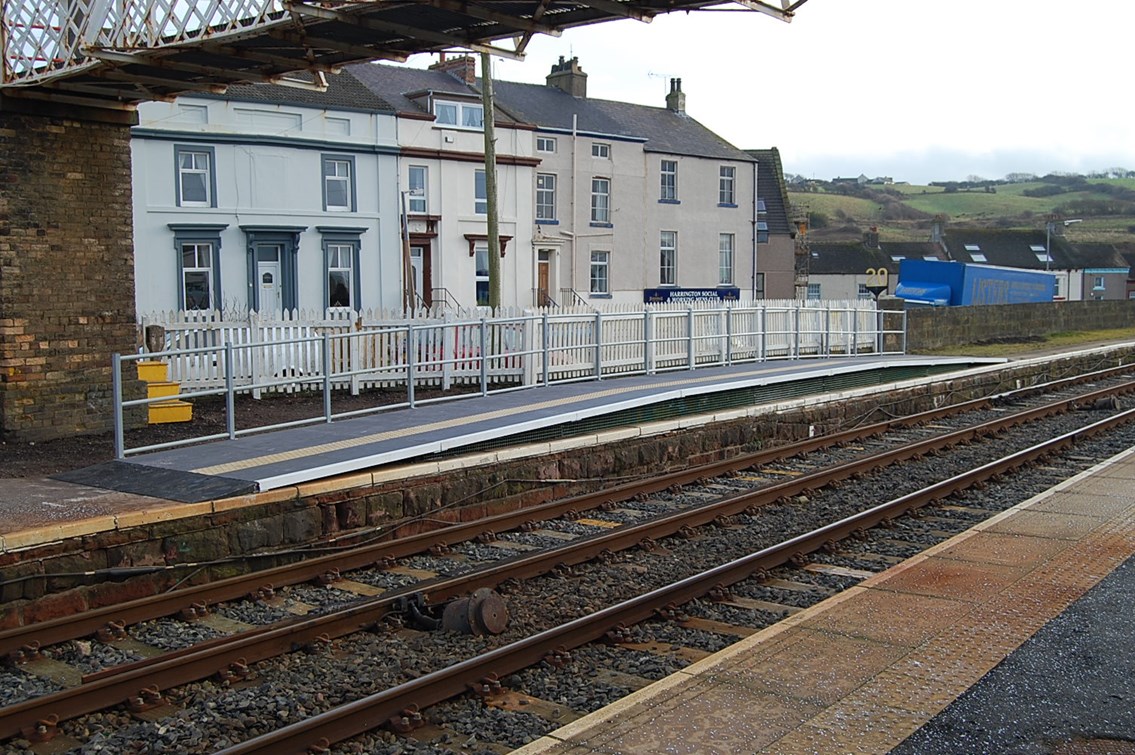Tuesday 9 Jun 2009
CUMBRIA TOWN TAKES ITS PLACE IN RAILWAY HISTORY
- Region & Route:
With a population of just 6,000 you would not expect a seaside ‘resort’ little bigger than a large village to take its place among the giants of railway history – but that is what is about to happen.
The name of Harrington will be forever remembered thanks to a pioneering innovation that was successfully trialled in the coastal town and that is set to revolutionise rail travel.
Nicknamed the ‘Harrington Hump’, it is a system for raising the height of platforms which in the past have been too low for all but the most able-bodied of rail travellers to use. Now, thousands of passengers throughout the country who have previously been denied access to the railway network could have untold journey opportunities opened up to them.
Developed in a joint initiative between Network Rail and Cumbria County Council, the new system is to be known permanently by its nickname. It can be custom built to suit the needs of the particular station and installed in a matter of days at a fraction of the accepted cost of rebuilding the platform.
Jerry Swift, head of corporate responsibility for Network Rail said: “It’s really exciting that working with colleagues in Cumbria County Council, DfT and Northern, we have been able to make a real difference for passengers at Harrington, and for a fraction of the cost of conventional methods. I look forward to more “Harrington Humps” across the country.”
John Kitchen, rail officer at Cumbria County Council added: "We have quite a few low platforms in Cumbria and the Harrington Hump is an effective low cost solution to the problem. We look forward to working with our partners in the railway industry to install many more of these simple and innovative structures for the benefit of Cumbrian passengers."
Railways first came to Britain almost 200 years ago. Different stations were built by different railway companies and there was no uniformity in their design. Consequently, the height of the platforms varied considerably.
This has left a legacy of stations for the modern-day railway that simply cannot be used by the elderly, by parents with children in buggies, by those with lots of luggage, and of course, the disabled.
The answer is a glass reinforced polymer – more commonly known as plastic – hump that comes in sections so it can built to any length. It is also variable in height so it will suit any platform, no matter how large the difference in height between the platform surface and stepping board of the trains. And, all important, it comes with ramps, making it ideal for anyone to use.
Development costs funded by Network Rail and the council were in the region of £60,000 but future production could be as little as £25,000 per installation. This compares with about £250,000 to rebuild a basic platform to bring it up to standard.
Low platforms are a typical problem for rural stations, such as Harrington, where they are only served by a handful of trains a day but are regarded as the lifeblood of the community. Unfortunately, finding half a million pounds to rebuild two station platforms simply cannot be justified in most cases.
Now it can be done for as little as a tenth of the cost, making it much more affordable. This is in turn means more people can use the trains, and the increase in passenger numbers can be the catalyst for further investment in the local railway, enhancing it even more to meet the increased demand.
The Harrington Hump is set to make life easier for passengers in St Albans Abbey, Hertfordshire and Aberdovey, Wales where Network Rail is working with the local authorities and communities to install the system.
Network Rail fully expects more orders to follow.
Notes to editors
The Harrington Hump is manufactured by Pipex Structural Composites of Plymouth, Devon. For further information contact Graham Carson or David Bateman on 01752 581200 or visit www.pipexstructuralcomposites.comContact information
Passengers / community members
Network Rail national helpline
03457 11 41 41
Latest travel advice
Please visit National Rail Enquiries
Journalists
Network Rail press office - North West & Central Region
0330 854 0100
NWCmediarelations@networkrail.co.uk
About Network Rail
We own, operate and develop Britain's railway infrastructure; that's 20,000 miles of track, 30,000 bridges, tunnels and viaducts and the thousands of signals, level crossings and stations. We run 20 of the UK's largest stations while all the others, over 2,500, are run by the country's train operating companies.
Usually, there are almost five million journeys made in the UK and over 600 freight trains run on the network. People depend on Britain's railway for their daily commute, to visit friends and loved ones and to get them home safe every day. Our role is to deliver a safe and reliable railway, so we carefully manage and deliver thousands of projects every year that form part of the multi-billion pound Railway Upgrade Plan, to grow and expand the nation's railway network to respond to the tremendous growth and demand the railway has experienced - a doubling of passenger journeys over the past 20 years.
Follow us on Twitter: @networkrail
Visit our online newsroom: www.networkrailmediacentre.co.uk

